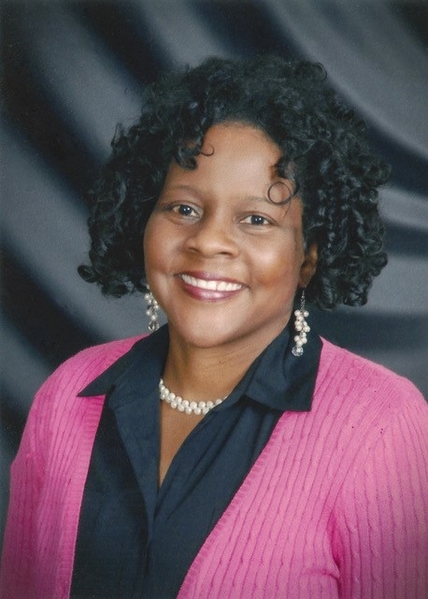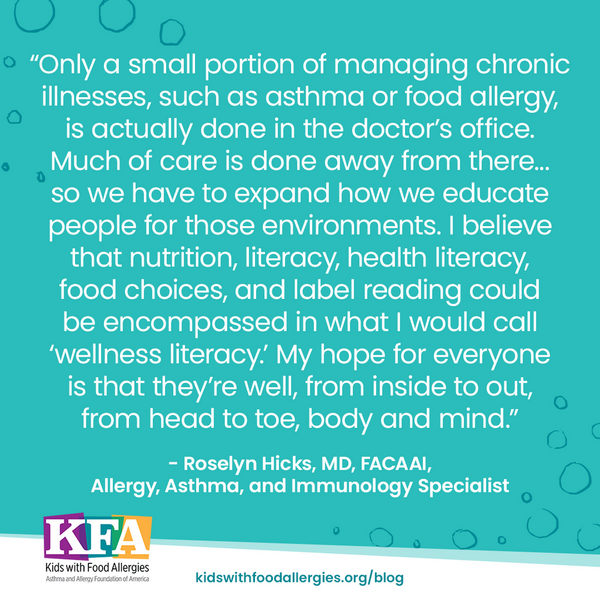Around one in 17 children has a food allergy, and one in 15 has asthma.1,2 In both food allergies and asthma, health disparities exist. Roselyn Hicks, MD, FACAAI, is working to overcome these disparities, most recently in Atlanta, Georgia, through education and improving health literacy.
Kids with Food Allergies (KFA) recently spoke with Dr. Hicks to learn more about her work and how she is working to change food allergy and asthma disparities among children in Georgia.
About Roselyn Hicks, MD, FACAAI
 Roselyn Hicks, MD, FACAAI, is a board-certified adult and pediatric allergy, asthma, and immunology specialist with more than 20 years of clinical, leadership, teaching, and private practice experience. Currently, as an Adjunct Assistant Professor at Morehouse School of Medicine in Atlanta, Georgia, she instructs medical students and residents. She also cares for and educates patients and their families at Children’s Healthcare of Atlanta. Prior to her time in Atlanta, she had a partner in a private practice at the Allergy & Asthma Center of North Carolina in Greensboro and Reidsville and was a clinical scholar at the National Institute of Minority Health and Health Disparities.
Roselyn Hicks, MD, FACAAI, is a board-certified adult and pediatric allergy, asthma, and immunology specialist with more than 20 years of clinical, leadership, teaching, and private practice experience. Currently, as an Adjunct Assistant Professor at Morehouse School of Medicine in Atlanta, Georgia, she instructs medical students and residents. She also cares for and educates patients and their families at Children’s Healthcare of Atlanta. Prior to her time in Atlanta, she had a partner in a private practice at the Allergy & Asthma Center of North Carolina in Greensboro and Reidsville and was a clinical scholar at the National Institute of Minority Health and Health Disparities.
Dr. Hicks is a proud alumna of Hampton University in Hampton, Virginia, and East Carolina University School of Medicine in Greenville, North Carolina. She completed her post-doctoral residency in pediatrics, followed by an allergy/immunology fellowship at the University of South Florida/All Children’s Hospital, in the Tampa/St. Petersburg area in Florida.
Dr. Hicks is a mentor, advocate, public speaker, and community engagement leader who is active in health policy work within the pediatric, allergy, and respiratory disease arenas. Since completing the Morehouse School of Medicine Satcher Health Leadership Institute Health Policy Leadership Fellowship, she has intensified her focus on health care disparities as a member of the Georgia Department of Public Health Asthma Advisory Board and as a liaison with the American Lung Association.
According to the CDC, “Health disparities are preventable differences in the burden of disease, injury, violence, or opportunities to achieve optimal health that are experienced by socially disadvantaged populations.” Vulnerable populations may include low-income individuals, women, children, older adults, and people in rural and tribal areas.
The major causes of health disparities in asthma and allergy include:
- Systemic racism (including bias in health care, segregation, discrimination, and historical trauma)
- Social determinants (such as socioeconomic status, education, neighborhood and physical environment, employment, social support networks, and access to health care)
Dr. Hicks is passionate about helping improve health disparities – as well as wellness overall – in Georgia through advocacy and education.
“After many years of private practice, where I regularly saw the same gaps (often more related to social determinants of health) within our medical sub-specialty in general and my desire to work more upstream, I pivoted more toward advocacy, youth wellness (not just health care), and public health,” Dr. Hicks said. “I appreciate there is much to be done to impact health policy and the opportunity to make even a small difference is encouraging.”
Dr. Hicks uses health literacy tools to advance health equity in her practice. Health literacy is how well people can find, understand, and use health information so they can make informed decisions. Part of health literacy is explaining health concepts using plain language. Using accessible tools and language is one way she helps families and children better understand how to manage their conditions and optimize their health.
According to Dr. Hicks, educating children in school is an impactful way of helping them improve the management of their conditions. Schools can be a helpful tool for sharing health and wellness knowledge. Children are already in a learning environment and are often very open to teaching.
“In school, they're there for learning,” Dr. Hicks said. “Let's utilize that. Only a small portion of managing even a chronic illnesses, such as asthma or food allergy, is actually done in the doctor's office. Much of care is done away from there – at school, at home, at work, at the restaurant, in the sports arena – so we have to expand how we educate people for those environments. I believe that nutrition, literacy, health literacy, food choices, and label reading could be encompassed in what I would call ‘wellness literacy.’ My hope for everyone is that they're well, from inside to out, from head to toe, body and mind.”

As a result, Dr. Hicks sees that better health literacy can decrease disparities. It can help people know how to better advocate for themselves, communicate with their health care team, and understand overall wellness.
Advocacy is also a key part of Dr. Hicks’s work. Knowing the needs of our local communities is a critical part of improving health disparities and health literacy.
“It is essential to collaborate with the community in need by participating in educational outreach events to advance health literacy to bring the unique desires of the local community, how, when, and where they are specifically requesting.”
Improving health literacy is one of many ways we can decrease disparities in food allergy and asthma management. The Asthma and Allergy Foundation of America (AAFA) and our food allergy division, Kids with Food Allergies (KFA), share Dr. Hicks’s passion for saving lives and reducing the burden of disease for people with food allergies and asthma. We offer educational materials written with health literacy in mind to help people better manage their conditions.
During National Asthma and Allergy Awareness Month, we hope you’ll share our mission and work to spread awareness. Through better understanding and awareness, we can improve the quality of life for people managing allergic diseases.
Learn more about health literacy.
How Can You Help Reduce Food Allergy Disparities?
The only way we can reduce health disparities is if we all work together. Everyone – from people with food allergies to policymakers and the health care industry – can be a part of building programs that make a lasting difference for people, families, and communities impacted by food allergies.
Sign up for KFA’s community to stay up to date about the following opportunities to get involved:
- Advocate for people affected by food allergy disparities
- Participate in patient-centered research and clinical trials|
You can also donate to support KFA’s mission to create real and lasting change.
References
1. Zablotsky, B., Black, L.I., & Akinbami, L.J.(2023). NCHS Data Brief, no 459: Diagnosed allergic conditions in children aged 0-17 years: United States, 2021. National Center for Health Statistics. https://dx.doi.org/10.15620/cdc:123250
2. National Center for Health Statistics. (2022). 2021 NHIS Child Summary Health Statistics. U.S. Department of Health and Human Services. https://data.cdc.gov/d/wxz7-ekz9



Comments (0)